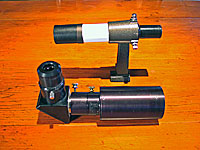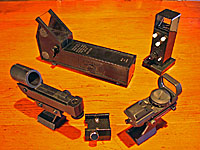

Finders
While you can 'sight along the tube' to aim your telescope, with a Dobsonian you will need to bend and/or kneel a lot and this gets tiresome quickly. Most people put some sort of finder on their telescope. It is easier to find your way around the sky with a wider field of view than your main telescope offers, which is often under 1°. Here we describe the two most popular types. For either type, you must take some time to align the finder with the telescope, so they are both looking in exactly the same direction.
Finder Scopes

Finder scopes are small, wide field refractors, and are the traditional and still very popular choice. For the type of Dobsonians we are making, a 30mm to 50mm finder scope is the appropriate size.
Finder scopes provide a larger aperture than the typical 5mm human eye, so they will show you objects fainter then your eye can see, but not as faint as your much larger telescope can show. The also will magnify, typically 6x to 9x.
The 35mm 'straight through' model shown in the photo does not offer interchangeable eyepieces, where as the 50mm model accepts standard 1¼ inch eyepieces (it is equipped with a 12mm Kellner that has a cross hair). It also has a 'star diagonal' which makes for much more convenient right-angle viewing.
The 35mm mounts in a standard dovetail fixture present on many commercial scopes (and dovetail mounting bases are available for home made scopes). The 50mm scope shown above is mounted in a pair of rings (not shown).
Many amateurs make finder scopes out of old binocular parts, either remounting the lenses in a tube, or mounting half a binocular on their scope.
Reflex Finders

A reflex finder projects a red locator on a transparent screen; you look through the screen and move the telescope until the locator is over the part of the sky you want to aim your telescope at. The locator is often a red dot, and many people call these 'red dot' finders, but various cross-hairs, bulls-eyes and other shapes of locators are commonly available (however they are all red).
These are also often erroneously called '0x' finders (they have no magnification, and so are working at '1x').
These have become very popular, as witnessed by the large number of models offered. They are simple to use, much lighter weight than a finder scope, and because you can see the entire sky when using them, offer a very wide field of view. However they offer no increase in object brightness or magnification. Their biggest disadvantage is they need power, and if your forget to turn them off, as many do, you will have a useless device until you install a new battery.
We will be installing one of these on our telescope - the one pictured at lower right in the photo.
Previous: Dust Covers & Dust
Caps Next: Tube Rings
Back to the Build a Dobsonian Master Index